
Mount Radford is an historic estate in the parish of St Leonards, adjacent to the east side of the City of Exeter in Devon.

Mount Radford is an historic estate in the parish of St Leonards, adjacent to the east side of the City of Exeter in Devon.



Edward Hancock (c. 1560–1603) was the son and heir of William Hancock (died 1587) of Combe Martin. He was MP for Plympton Erle (1593), Barnstaple (1597) and Aldborough (1601). He matriculated at Trinity College, Cambridge in 1578 and entered the Inner Temple c.1580 and was called to the bar in 1590. He was Clerk of Assize on the western circuit in 1590. [3] He married Dorothy Bampfield (died 1614), daughter of Sir Amyas Bampfylde (1560–1626), MP, of Poltimore near Exeter and North Molton in North Devon. Edward Hancock committed suicide on 6 September 1603. He left a one-year-old son and heir William II Hancock (1602–1625). Dorothy survived her husband and received Mount Radford as her dower house, where she lived with her second husband. [4] She remarried to the highly influential Sir John Doddridge (1555–1628), a Justice of the King's Bench, and contemporary of her father, who had purchased as his seat the North Devon estate of Bremridge, near Dorothy's father's seat of North Molton. She was a Maid of Honour to Queen Elizabeth I and has a sumptuous monument to her memory in the Lady chapel of Exeter Cathedral, next to that of Dodderidge.[ citation needed ]
The father of William II Hancock (1602–1625) committed suicide when William was an infant aged one year. His mother, Dorothy Bampfield, then remarried, as his 2nd wife, the highly influential Sir John Doddridge (1555–1628), a Justice of the King's Bench, and contemporary of her father, who had purchased as his seat the estate of Bremridge, near Dorothy's father's seat of North Molton. They had no children. His mother then Lady Dodderidge died in 1617 when William was aged 15 and he appears to have remained in the care of his step-father Dodderidge, who remarried to Anne Culme, the granddaughter of Hugh II Culme (d.1545) of Molland-Champson, a manor adjoining North Molton. Anne thus effectively became William's step-mother. She had previously been married to Gabriel Newman, a member of the Worshipful Company of Goldsmiths in the City of London, to whom she had borne a daughter Judith Newman (1608–1634), who was 6 years william's junior. The Newman (or Neuman) family later were seated at Baconsthorpe in Norfolk, in the parish church of which are some grave-slabs sculpted with the family's arms. [5] At or before her 17th birthday she and the 23-year-old William were married and had two children:
At the time of her 1st husband's death in 1625 Sir John Dodderidge and his wife Anne Culme were then still living and presumably had some part in the care of the now fatherless infant. Judith soon remarried to Thomas II Ivatt, but died aged 26 having given birth to a son and heir Thomas III Ivatt, who later resided at Shobrooke near Crediton. Thomas II Ivatt was the eldest son of Thomas I Ivatt (d.1629), who had purchased in 1624 for the sum of £3,000 a lease of the profitable office of "Searcher of the Port of London" the reversion of which he bequeathed in his will to his son Thomas II Ivatt together with the sum of £400 to cover the cost of acquiring a new royal patent. [6] Philipa, The widow of Thomas I Ivatt, of unknown family, was a lunatic, and her wardship was sold by the king in 1629 to the poet Aurelian Townsend (d.1643) [7] They had the following progeny:

Judith's second husband Thomas II Ivatt erected a monument with a bust in white marble of his wife in Combe Martin church, positioned on the north wall of the north aisle chapel above the vestry door. This is similar in design to the contemporary monument to Penelope Noel in Chipping Campden Church, Gloucestershire. It is inscribed thus:
"Memoriae Amoris Sacrum. (Sacred to the memory of Love) Here lyeth the body of Judith first the wyfe of William Hancock Lord of this mannor by whome she had issue John & Ann, after the wyfe of Thomas Ivatt Es(q) some tymes His Ma(jes)t's printcipail sercher in the Port of London at whose cost this monument was erected. Shee had issue by him Thomas & Judith Ivatt. Shee departed this life 28 May 1634 A(nn)o Aetatis 26. (in the year of (her) age 26) Solus Christus mihi salus". (Christ alone is salvation to me)
"Grace meekenes love religion modistye
Seem'd in this mirrour of her sex to dye
For hir soule's lover in hir lyfe did give
To hir as many vertues as could live
And thus full beutifyed by heavenly arte
Earth claim'd hir body Heaven hir better parte"
Judith was buried in the middle of the aisle of this chapel, in the floor of which exists a large sandstone ledger slab inscribed thus:
"Fuimus (We Were) Here lyeth the body of Judith Ivatt wife of Thomas Ivatt Es(q). for whome he lay'd this stone & erected the monument in the north isle of this chancel. Erimus" (We shall be).


John Hancock (1625–1661), eldest son and heir, who was an infant aged 1 year at his father's death. He became a ward of the king. [9] He married Mary Sainthill, daughter of Peter Sainthill (1596–1648) of Bradninch, by whom he had 3 children:

John Colesworthy was the owner of the estate in 1755 when he was declared bankrupt and sold the house with 17 acres of land to John Baring (1730–1816) for 2,000 guineas. [26]

Mount Radford was next acquired by the Baring family, substantial local merchants and bankers who founded the international banking house of Baring Brothers.
In 1810, he had an additional residence at West Teignmouth House in the parish of West Teignmouth. [29] In 1816, the last year of his life, he encountered financial difficulties and sold Mount Radford and his other Exeter properties to his cousin Sir Thomas Baring, 2nd Baronet (1772–1848), who in 1826 sold them to a commercial builder. [30] A memorial to members of the Baring family of Mount Radford and Larkbeare exists in the late Victorian (1876–86) St Leonard's Church on Holloway Street, which replaced the small classical church built in about 1831 (enlarged in 1843 for £800, of which £500 was donated by Sir Thomas Baring [31] ), which itself replaced the mediaeval parish church. [32]
In 1826 the house became a school, known variously as "Mount Radford School", "The Exeter Public School" [33] or "Mount Radford College". The school remained extant in nearby buildings after Mount Radford House was demolished in 1902. [34]
In 1832 the horticulturalist James Veitch (1792–1863), who worked for the Aclands of Killerton, purchased 25 acres of land on the estate.[ citation needed ]
In 1902 the house was demolished and the grounds were used for housing development now forming part of the eastern suburbs of Exeter. The area is now covered by Barnardo Road and Cedars Road. [35]

The Cary family is an English aristocratic family with a branch in Ireland. The earliest known ancestor of the family is Sir Adam de Kari who was living in 1198. Sir John Cary purchased the Manor of Clovelly in the 14th century and established the family's status as members of the landed gentry. Various branches of the family were ennobled in the late 16th and early 17th centuries as Baron Hunsdon and Viscount Falkland.

Trerice is an historic manor in the parish of Newlyn East, near Newquay, Cornwall, United Kingdom. The surviving Tudor manor house known as Trerice House is located at Kestle Mill, three miles east of Newquay. The house with its surrounding garden has been owned by the National Trust since 1953 and is open to the public. The house is a Grade I listed building. The two stone lions on the front lawn are separately listed, Grade II. The garden features an orchard with old varieties of fruit trees.
Rev. John Prince (1643–1723), vicar of Totnes and Berry Pomeroy in Devon, England, was a biographer. He is best known for his Worthies of Devon, a series of biographies of Devon-born notables covering the period before the Norman Conquest to his own era. He became the subject of a sexual scandal, the court records of which were made into a book in 2001 and a play in 2005.

Sir John Acland, 1st Baronet of Acland in the parish of Landkey and of Columb John in Devon, England, was a Royalist commander in the Civil War, during the early part of which he maintained a garrison for the king on his estate of Columb John. He was created a baronet in 1644 for his support, but the letters patent were lost or never finalised and the dignity was not confirmed until 1677/8, long after his death. He compounded with Parliament for his estate in 1646 and died the following year.

Huntsham is a small village and civil parish, formerly a manor and ecclesiastical parish, in the Mid Devon district of Devon, England. The nearest town is Tiverton, about 5.8 miles (9.3 km) south-west of the village. The parish is surrounded clockwise from the north by the parishes of Bampton, Hockworthy, Uplowman and Tiverton; it is bounded on the east by the River Lowman and by a minor road on Bampton Down to the north west, where it reaches a maximum height of 914 feet (279 m). In 2001 the population of the parish was 138, down from 222 in 1901.
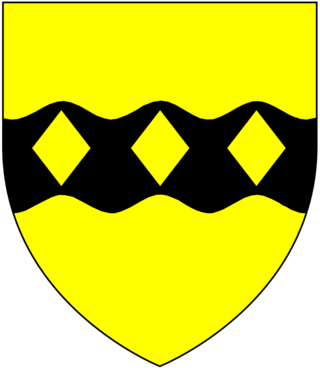
Nicholas Duck, of Heavitree and of nearby Mount Radford in the parish of St Leonards, both next to Exeter in Devonshire, was an English lawyer who served twice as a Member of Parliament for Exeter, in 1624 and 1625. He was one of the Worthies of Devon of the biographer John Prince (1643–1723), whose wife was his great-niece.
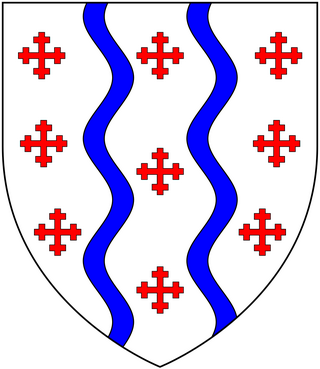
John II Dodderidge (1610–1659) of Bremridge in the parish of South Molton, Devon, was a lawyer who was elected MP for Barnstaple in 1646 and 1654, for Bristol in 1656 and for Devon also in 1656, and chose to sit for Devon, but was prevented by Oliver Cromwell from taking his seat.

The landed gentry and nobility of Devonshire, like the rest of the English and European gentry, bore heraldic arms from the start of the age of heraldry circa 1200–1215. The fashion for the display of heraldry ceased about the end of the Victorian era (1901) by which time most of the ancient arms-bearing families of Devonshire had died out, moved away or parted with their landed estates.
The Manor of Combe Martin was a medieval manor estate in Combe Martin, Devon, England.

Sir Arthur Acland (1573–1610) of Acland in the parish of Landkey, Devon, was a member of the Devonshire gentry, and was knighted in 1606. Little is known of his life and career, but his monumental inscription survives above his impressive monument in Landkey Church. His son was Sir John Acland, 1st Baronet. He was ancestor to the prominent, wealthy and long-enduring Acland family of Killerton, which survives today in the direct male line.

The estate of Acland in the parish of Landkey, near Barnstaple in North Devon, England, was from 1155 the earliest known seat of the influential and wealthy family of Acland, to which it gave the surname de Acland. It is situated about 3/4 mile north-east of the village of Landkey, from which it is now cut off by the busy A361 North Devon Link Road.

Newnham Park is an historic estate in the civil parish of Sparkwell, Devon, UK. It was known as Loughtor until about 1700 when the ancient Strode family, long seated at Newnham, about 1 mile south-east of the manor house of Loughtor, abandoned Newnham and moved their residence to Loughtor where they built a new mansion house which they renamed "Newnham Park". In 2014 the mansion house with an estate of about 1,550 acres is still owned by a descendant of the Courtenay and Strode families which held the estate from the 15th century, and which were well established in the county of Devon long before that time. In 2014 part of the estate is operated as a commercial clay-pigeon shooting ground.
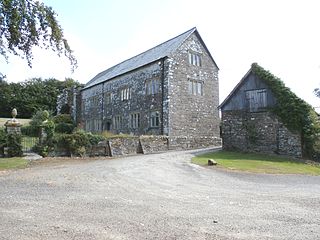
Bremridge is a historic estate within the former hundred of South Molton in Devon, England. It is now within the parish of Filleigh but was formerly in that of South Molton. It is situated 8 miles north-west of South Molton. Since the construction of the nearby A361 North Devon Link Road direct access has been cut off from Bremridge to Filleigh and South Molton. The surviving wing of the mansion house built in 1654 is a Grade II* listed building. Bremridge Wood is the site of an Iron Age enclosure or hill fort, the earthwork of which is situated on a hillside forming a promontory above the River Bray. In Bremridge Wood survives a disused tunnel of the former Great Western Railway line between South Molton and Barnstaple, much of the course of which has been used for the A361. The tunnel is 319 yards long and was identified as "Bremridge Tunnel" in the 1889 Ordnance Survey map but as "Castle Hill Tunnel" in subsequent editions.

Creedy is an historic estate in the parish of Sandford, near Crediton in Devon. It is named from its location on the west side of the River Creedy. It was the seat of the Davie family from about 1600 until the late 20th century. The mansion house on the estate has been called at various times New House, Creedy House, and as presently, Creedy Park. It was first built in about 1600, rebuilt in 1846, burnt down in 1915 and rebuilt 1916–21. It is surrounded by a large park, the boundary of which is enclosed by a stone and brick wall several miles long.
The Manor of Clovelly is a historic manor in North Devon, England. Within the manor are situated the manor house known as Clovelly Court, the parish church of All Saints, and the famous picturesque fishing village of Clovelly. The parish church is unusually well-filled with well-preserved monuments to the lords of the manor, of the families of Cary, Hamlyn, Fane, Manners and Asquith. In 2015 the Rous family, direct descendants via several female lines of Zachary Hamlyn (1677–1759) the only purchaser of Clovelly since the 14th century, still own the estate or former manor, amounting to about 2,000 acres, including Clovelly Court and the advowson of the parish church, and the village of Clovelly, run as a major tourist attraction with annual paying visitor numbers of about 200,000.

Sharpham is an historic estate in the parish of Ashprington, Devon. The Georgian mansion house, known as Sharpham House, overlooks the River Dart and is a Grade I listed building. The house was commenced in about 1770 by the Royal Navy captain Philemon Pownoll to the designs of the architect Sir Robert Taylor (1714–1788). In the opinion of Nikolaus Pevsner it contains "one of the most spectacular and daring later 18th century staircase designs anywhere in England". The park and gardens are Grade II* listed in the National Register of Historic Parks and Gardens. Part of the descent of Sharpham is shown on the Palmes family heraldic pedigree roll.

Hawkridge in the parish of Chittlehampton in North Devon, England, is an historic estate, anciently the seat of a junior branch of the Acland family which originated at nearby Acland, in the parish of Landkey and later achieved great wealth and prominence as the Acland Baronets of Killerton, near Exeter. The former mansion house is today a farmhouse known as Hawkridge Barton, a grade II* listed building. The Devon historian Hoskins (1959) stated of Hawkridge: "Externally there is nothing remarkable except a decaying avenue of ancient walnuts, so often the first indication of a 16th or 17th century mansion". The interior contains a fine plaster heraldic overmantel showing the arms of Acland impaling Tremayne, representing the 1615 marriage of Baldwin Acland (1593–1659) of Hawkridge and Elizabeth Tremayne.
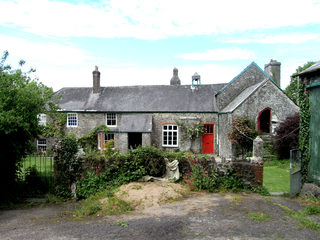
Woolleigh is an historic estate in the parish of Beaford, Devon. The surviving mansion house known as Woolleigh Barton, situated 1 3/4 miles north-west of the parish church of Beaford, is a grade II* listed building, long used as a farmhouse. It incorporates remains of a "very fine example of a late Medieval manor house" and retains a "very rich" 15th century wagon roof, a garderobe with the original door, and an attached private chapel with a 17th-century roof.
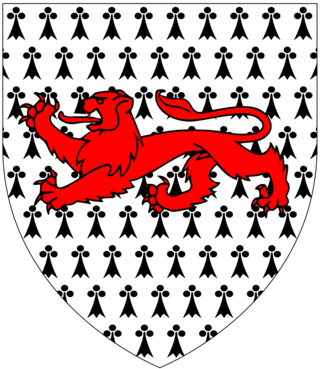
The Drewe family of Broadhembury are generation owners and inhabitants of The Grange, Sharpham, Broadhembury, Wadhurst Park, Devon, in the west and east of England, from the 16th century to the current date.

Spridleston is an historic manor in the parish of Brixton in Devon, England, long a seat of a branch of the prominent and widespread Fortescue family. The ancient manor house does not survive, but it is believed to have occupied the site of the present Spriddlestone Barton, a small Georgian stuccoed house a few hundred yards from the larger Spriddlestone House, also a Georgian stuccoed house, both centred on the hamlet of Spriddlestone and near Higher Spriddlestone Farm.